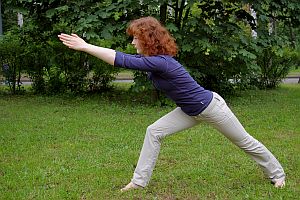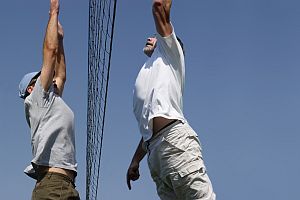Use it or Lose it: Five Tips for Maintaining Your Sense of Balance Beyond Middle Age
 If you are middle-aged (40-60, by some definitions) or older, here’s 15-second self-test for you. Do you often find yourself needing to sit down or steady yourself against a table when putting on your shoes or stepping into pants? Do you increasingly need to use the armrests of your chair to “push off” when getting up? Do you generally hold on to handrails whenever you go up and down stairs? If you stand with your feet close together, do you feel unsteady and unable to balance yourself properly?
If you are middle-aged (40-60, by some definitions) or older, here’s 15-second self-test for you. Do you often find yourself needing to sit down or steady yourself against a table when putting on your shoes or stepping into pants? Do you increasingly need to use the armrests of your chair to “push off” when getting up? Do you generally hold on to handrails whenever you go up and down stairs? If you stand with your feet close together, do you feel unsteady and unable to balance yourself properly?
If you’ve answered “Yes” to any of these questions, you might want to start giving a little bit of thought to your sense of balance, and how important it is to you. It’s easy to take good balance for granted—most people don’t give it a first or second thought until after they’ve experienced a fall. However, the behaviors we asked about in our self-test are actually “early warning signs” that your sense of balance may be starting to deteriorate. Your balance is controlled by an area of the brain called the cerebellum, which works in coordination with your vestibular (inner ear) system, your visual system (your eyes, and their ability to perceive whether you are standing upright), and your proprioceptive system (your body’s sense of position in space).
All of these systems begin to deteriorate once you pass the age of 40, as do the muscles they control. Worse still, this process of deterioration can become accelerated if you lead a sedentary lifestyle (which growing numbers of Americans do). And although you might not think of balance as a health issue, falling is the leading cause of injury for people over the age of 65. In the U.S., someone from this age group is treated in an emergency room for injuries resulting from a fall every 17 seconds.
So how do you improve your sense of balance, and protect yourself from dangerous falls? Simple—use it! Balance is to some extent a learned skill, so if you practice a few simple exercises that isolate these components of balance, you can actually make your sense of balance better. Experts on aging suggest performing a few exercises to improve your balance each day, starting in middle age, before the systems that control your balance have begun to deteriorate.
For example, just avoiding the use of handrails on stairs or the poles in buses and subway cars forces your body to work harder to maintain its balance, improving reflexes, increasing coordination and strengthening your muscles. Other exercises you can perform include creating an unstable surface at home (such as a board placed on wobbly pillows) and then practicing standing on it with one foot, or improving your coordination by standing on one leg with the opposite arm extended and then swinging the other leg back and forth. Office workers can improve their balance—and get a refreshing break at the same time—by practicing getting up from their chairs ten times in a row without using their hands. Each of these simple movements shifts your center of gravity, causes your muscles to react to changing positions, and improves your balance.
Just walking in a small circle around your living room or your backyard can be good for your balance, because walking along a curve is more difficult than walking in a straight line. When you’re out for a walk, try to choose uneven surfaces rather than smooth pavement because this also exercises the muscles in your back and legs that are essential for good balance. Or place cones or other objects in a line on the floor in front of you and then weave between them while walking. You can strengthen your hips, which are very important for balance, by holding on to a table or a kitchen counter and then swinging one leg forward, to the side, to the back, and then up to your chest with your knee bent. Do this ten times, and then switch to the other leg and repeat. Yoga, Tai Chi, martial arts, and other forms of exercise that emphasize flexibility can also improve your balance.
So if you are concerned about protecting yourself against falls as you age, the important thing to bear in mind is the phrase “use it while you’re young, or you’ll lose it as you age.” The more healthy exercise you get in your 30s and 40s, the more healthy – and safe – you’ll be in your 60s and beyond.
